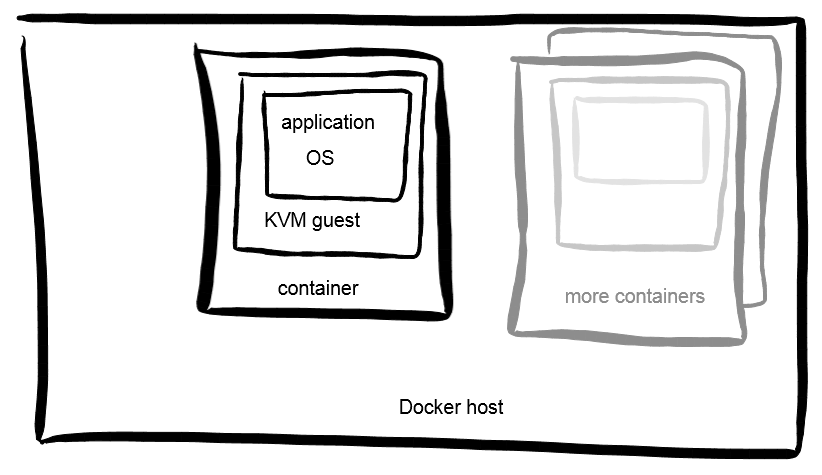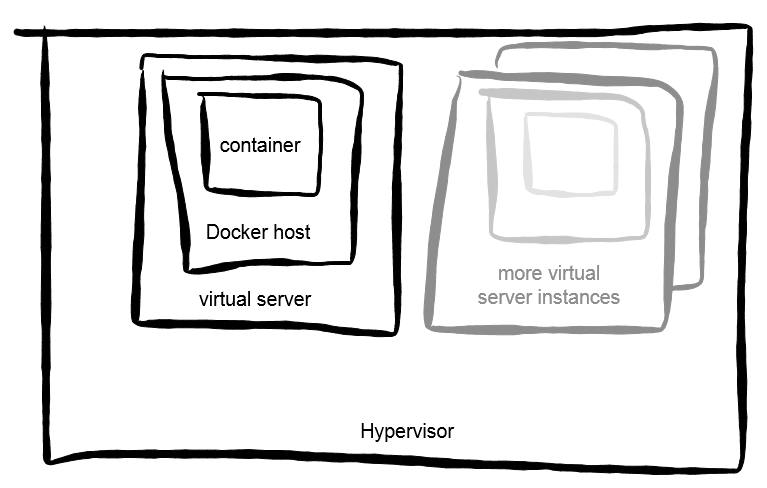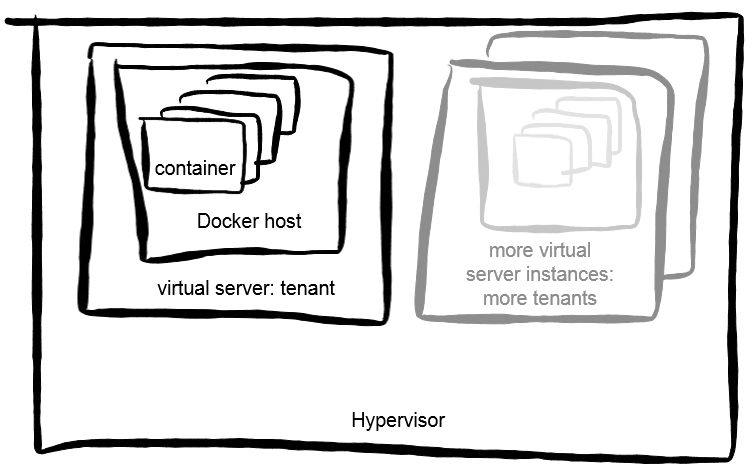virtualization-vs-containerization
http://containerz.blogspot.com/2015/03/virtualization-vs-containerization.html
Virtualization vs. Containerization
With system virtualization, the hypervisor provides a full virtual machine to a guest: the entire OS image including the kernel is now dedicated to the virtual machine. CPU virtualization is used to provide each guest with an exclusive view of a full system environment, and these mechanisms also ensure isolation from other guests. Hypervisor-based management of virtual CPUs, memory and I/O devices is used to define resource consumption of guests.
Which one is better?
As always, it depends on your needs. If you just want to have a number of separate instances to run applications, a container environment often provides greater efficiency, both in managing the application environment, starting the application instances, and in resource consumption. Simple modification and deployment of application environments has been a design principle of container solutions like Docker and is entirely in the DevOps spirit (guess you just have been waiting for more buzzwords).
If you want to have best isolation of environments and come from a server virtualization perspective, then system virtualization may be more relevant: Noisy neighbours are much less of an issue than with containers. While many of the container folks currently focus on improving container isolation, virtual machine isolation is still superior. Coming from physical servers, virtual servers are a natural step, and an existing ecosystem around server management can often be applied to virtual servers, too.
On z systems, Linux has good scalability (to run containers), but z is the platform with an extremely efficient virtualization technology (to run virtual servers), and it is inherent in the entire system architecture. Without having measured it, combining the technologies is probably less painful on z Systems than on other platforms.
There is a third way: both.
Combining system virtualization with containers can be done in multiple ways:
1. A Virtual Machine in a Container

Docker has quite some flexibility on where containers are deployed. One option (called "execution driver") is to use KVM images. This allows to use all the DevOps methods of Docker and combine it with best isolation available, at the cost of having to start up entire Operating System instances when starting containers -- meaning startup time and footprint. Memory efficiencies can only be realized through Kernel Samepage Merging (KSM) -- less effective and efficient, but it's a start.
2. A Container in a Virtual Machine

Conversely, you can run a virtual machine and start a container inside. The VM would not be controlled by Docker, but by existing virtualization management infrastructure. Once the OS instance is up, starting a container would then be done using Docker, and no special setup has to be performed for running containers. Again, containers would have strong isolation since the next container runs in another virtual system; footprint-wise, efficiencies would only be possible through memory deduplication techniques by the hypervisor.
2b. Multiple Containers in a Virtual Machine

This is a variation of running Docker in a VM, suitable for multi-tenancy environments. Here, the assumption is that strongest isolation is only required between containers of different tenants, and straight Linux container isolation is good enough between several containers of the same tenant. Advantages are lower number of virtual machines to run, best isolation between tenants, and enjoying all the efficiencies of vanilla Docker setups.
To summarize: it depends.
virtualization-vs-containerization的更多相关文章
- [WPF]WPF Data Virtualization和UI Virtualization
这篇博客将介绍WPF中的虚拟化技术. 1. Data Virtualization 通常情况下我们说数据虚拟化是指数据源没有完全加载,仅加载当前需要显示的数据呈现给用户.这种场景会让我们想到数据分页显 ...
- Geneve: Generic Network Virtualization Encapsulation
Earlier this year, VMware, Microsoft, Red Hat and Intel published an IETF draft on Generic Network V ...
- [Virtualization][SDN] VXLAN到底是什么 [转]
写在转发之前: 几个月以前,在北大机房和燕园大厦直接拉了一根光钎.两端彼此为校园内公网IP.为了方便连接彼此机房,我做个一个VPN server在燕园的边界,北大机房使用client拨回.两个物理机房 ...
- Virtualization API之libvirt
The virtualization API 之开源 libvirt探究 By Ruiy: libvirt supports Hypervisors(注,相关的hypervisors项目的权威网站已经 ...
- this computer does not support Intel Virtualization Technology (VT-x) .Haxm can'not be installed
this computer does not support Intel Virtualization Technology (VT-x) .Haxm can'not be installed 本机不 ...
- 【转】How to Start Intel Hardware-assisted Virtualization (hypervisor) on Linux to Speed-up Intel Android x86 Emulator
[转]How to Start Intel Hardware-assisted Virtualization (hypervisor) on Linux to Speed-up Intel Andro ...
- Connecting Docker for Cloud Services using SDN and Network Virtualization
Abstract The explosive scale of container CPUs needs highly efficient network virtualization Chal ...
- RH133读书笔记(10)-Lab 10 Exploring Virtualization
Lab 10 Exploring Virtualization Goal: To explore the Xen virtualization environment and the creation ...
- <Mastering KVM Virtualization>:第一章 了解Linux虚拟化
本章为读者提供了Linux虚拟化中流行技术的深刻见解,以及相较于其他同类技术的优势特点.本书共有14章,囊括了KVM虚拟化中的各个方面,从KVM的内部构造开始,并包括了诸如软件定义网络(SDN),性能 ...
随机推荐
- Java实现Dijkstra算法求最短路径
任务描述:在一个无向图中,获取起始节点到所有其他节点的最短路径描述 Dijkstra(迪杰斯特拉)算法是典型的最短路径路由算法,用于计算一个节点到其他所有节点的最短路径.主要特点是以起始点为中心向外层 ...
- [light oj 1013] Love Calculator
1013 - Love Calculator Yes, you are developing a 'Love calculator'. The software would be quite comp ...
- [c#美味] Guid ToString 格式知多少?
在日常编程中,Guid是比较常用的,最常见的使用就是如下所示: string id = Guid.NewGuid().ToString(); 这条语句会生成一个新的Guid并转成字符串,如下: // ...
- python解析AMF协议
最近看公司同事在玩页游<斗破乾坤>我也进去完了一把,感觉画面还不错,就是不停的点鼠标做任务,一会就烦了,看了下前端配置文件,我们以error.json_3e30为例,这个肯定是记录错误码的 ...
- HDU-5373 The shortest problem
The shortest problem http://acm.hdu.edu.cn/showproblem.php?pid=5373 Time Limit: 3000/1500 MS (Java/O ...
- [codevs2152]滑雪
题目来源 http://www.tyvj.cn/p/1004 http://www.luogu.org/problem/show?pid=1434# http://codevs.cn/problem/ ...
- 新花生壳内网版2.3 + Tomcat7 搭建自己的网站(2015.01.21)
网上很多资料,问题主要是出在 tomcat 的访问上而已: 如下总结一下: 首先在 花生壳 官网(http://hsk.oray.com/)注册一个帐号,每个帐号可以领取一个免费域名 然后下载安装新版 ...
- 【Java基础】Java内部类
什么是内部类 把类定义在其他类的内部,这个类就被称为内部类. 内部类的分类 内部类分为两种,分别为成员内部类和局部内部类: 成员内部类:和成员变量和成员方法定义在同级 局部内部类:和局部变量定义在同级 ...
- html5 做游戏 Quintus Sublime Text牛逼的神器
- 局域网接入Internet
说在前面的话 局域网接入Internet的方式多样: 有1传统的Modem(调制解调器)拨号接入,费用低廉的2 ISDN和 3 ADSL接入,费用较高的4 DDN专线接入,5 Cable Modem高 ...
